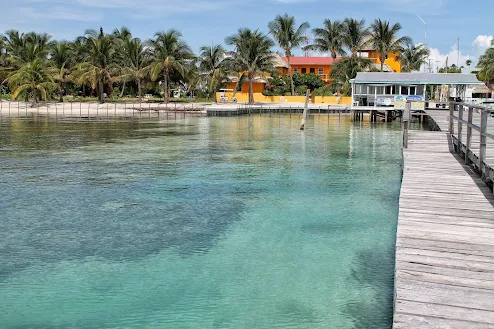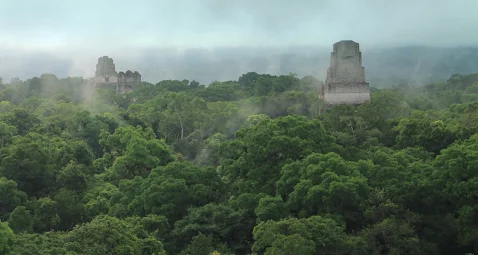BELIZE
303 Kilometres – 13 Days
19 August – 1 September 2012
19-20 August - Melchor de Mencos, Gautemala –
San Ignacio, Belize - 18 kilometres
The Gautemala-Belize border was located on
the outskirts of town and soon we found ourselves in tiny Belize. I say tiny as
the country was about 290 kilometres long and 110 kilometres wide and had a
population of about 320,000. Belize is the only country in Central America with
a British colonial heritage. Therefore, it’s the single country where English
is the official language, albeit with a heavy Caribbean accent. As a result, many
Belizeans speak a mix of Creole and English among friends and switch to “full
English” when speaking to foreigners. The strong Caribbean accent took time to
get used to, but anyone could understand a friendly “gud mawnine”.
A short distance led to San Ignacio which
sported a campsite right in the centre of town. As always, Ernest again needed bike
spares after crossing the border. He looked around but couldn’t find a bike
shop.
In the meantime, we met the bush doctor who recommended
Noni juice for Ernest’s ailments. Later he returned with foul-smelling stuff in
a jar. Ernest bravely drank it; lo and behold, would he not feel much better. I
surmised he was given more than Noni juice.
I usually sleep well in my tent but this
night was different. Red ants somehow got into the tent and I awoke to ants
slowly and systematically devouring me.
21 August - San Ignacio – Belmopan - 40
kilometres
Belize is a relatively small country where
nothing is very far, and people are friendly. Not only did a lady stop to give
me a bottle of icy cold coconut juice, but a kind passer-by handed me a bunch
of bananas. While waiting for Ernest to catch up at a bus stop, I had a long
and interesting conversation with a lady waiting for her bus. The Belizeans
were hospitable, chatty, and highly interested in where we came from.
A short cycle ride took us to Belmopan, the
capital, a relatively small village instead of a city. Belmopan is a “built”
city and was established in 1961 after Hurricane Hattie wiped out a considerable
amount of Belize City. The town, therefore, appeared dead and the vast parks
and gardens around the government buildings were deserted. We assumed we had to
apply for a Mexican visa in Belmopan, but following enquiries at the embassy were
told to apply in Belize City.
22 August - Belmopan - Belize City - 83
kilometres
While heading in the direction of Belize City,
we, at last, reached level ground. But, as with flat areas, one always seems to
be into the wind. Ernest nursed his bike along; as soon as he applied pressure
to the peddles, the chain snapped.
We moved along slowly but still got to Belize
City in good time, where we weren’t referred to as gringos, but as simply as “White
Boy” or “White Woman”. LOL!
Belize City was significantly livelier than
Belmopan and gave hope of finding a bike shop. We did indeed spot two shops but
none had the necessary parts. Locating lodging was far easier, as kind Belizeans
were ever ready to point one in the right direction.
The following morning was for visiting the Mexican
embassy, and getting a visa was quick and uncomplicated. Not only was it fast
but being issued a free six-month visa, instantly endeared me to Mexico.
Afterwards, Ernest set out looking for a bike shop and, in the process, found nearly
all the items he needed.
Trundling around town was rather interesting and
music seemed everywhere. The Garifuna are master percussionists, and I was
convinced I would know every Bob Marley song by heart upon leaving Belize.
24-27 August - Belize City – Caye Caulker -
By water taxi (45min)
The place to go to in Belize was the islands.
Water taxis plied the water between the mainland and the Cayes, and we jumped
on one and sped off at full throttle across the calm Caribbean Sea to Caye
Caulker. A welcoming and easy-going place where the motto was “Go Slow”.
Caye Caulker is a tiny island, at most 800m
long and no more than 300m wide. Welcoming dreadlocked and laidback islanders
eagerly await one as you step off the ferry, ready to point you in the right
direction (or sell you the good stuff). While looking for a place to pitch a
tent, we were pointed toward a nearby campground. The helpful gentleman
mentioned that if he had a bike, he could’ve shown us the way – keep in mind we
were almost in the middle of the 800m long island. LOL!
The Go-Slow motto of the island was taken
quite literally. Being a teeny island, everyone knew each other. There was no
rushing from place to place, as these friendly people made striking up a
conversation easy. On the other hand, going to the little supermarket to pick
up milk could be a lengthy process as everyone knew we had been cycling and
hailed from South Africa, two facts that seemed to amuse them tremendously.
They chuckled at the fact we were white and from Africa and they were black and
from Central America. To them, it was even more amusing that we cycled to
Belize, as the furthest most of them have been on a bike, was around the
island.
We lazed the days away, dipping in the Caribbean's
warm, crystal-clear water, listening to reggae music and sipping beer at the
Lazy Lizard Bar. Finally, I gave in and took a boat to the nearby reef for a snorkel
trip. I snorkelled to my heart’s content and swam with nurse sharks, stingrays,
moray eels, and schools of fish. I wish I had a camera to capture the
experience.
28 September - Caye Caulker – Belize City (by
ferry) - Crooked Tree - 62 kilometres
Eventually, the time came to leave the island
and return to the mainland. We were relatively slow in packing up but still
managed to get the 10h00 water taxi to Belize City (it was a good thing it was
late). After repacking the bikes, it was 12h00 by the time we departed and
slowly made our way north.
About fifty-five kilometres further, a sign pointed
to Crooked Tree and, as I found it hard to cycle past a place with a name like
Crooked Tree, we made the detour. Down a rough dirt road of about six
kilometres was the village of Crooked Tree, located on Crooked Tree Lagoon. The
entire area had been declared a wildlife sanctuary for its birdlife. As
accommodation was expensive, we asked to pitch our tents under a massive mango
tree. All this happened to the great amusement of the villagers as they had never
had such a request.
29 August - Crooked Tree – Orange Walk - 47
kilometres
We woke to the coarse croaking of a toucan
and the chirping of various birds. It rained heavily during the night, making our
patch somewhat muddy, and we dried our tents in the early morning sun before
setting out to Orange Walk.
Orange Walk was a small but lively town,
where one could still find old-fashioned tortilla factories. The settlement was
situated along the banks of the New River, once a major waterway for the
ancient Maya. A cabana next to the river, where the river was covered in water
lilies and where little tables under thatched roofs were right in the water, was
our peaceful abode for the night.
30 August - Orange Walk
The next morning, a boat ride took me up the New
River to Lamanai, nearby Mayan ruins. The river trip was fabulous and provided
an abundance of birdlife, crocodiles and monkeys.
Lamanai was simply magical. It’s one of the
largest Mayan sites in Belize and holds over 800 structures. The site is
situated deep in a tropical forest. I believe Lamanai was occupied as early as
1500 BC and remained so for over 3,000 years. Historians suspect its remoteness
most likely contributed to its continuous occupation, well beyond other Mayan sites,
until at least 1650 AD.
31 August - Orange Walk – Corozal - 53
kilometres
The ride to Corozal, the northernmost town in
Belize, was short but into a headwind, past vast sugarcane fields. The wind
grew stronger, and we opted for accommodation in Corozal. It was a good thing
too, as no sooner had we offloaded, than the rain came bucketing down.
Later that evening, after the rain had
subsided, a leisurely saunter took us to the square and supermarket. Not much
happened in teeny Corozal and I contemplated investigating the nearby ruins.
Still, it involved a boat ride and the sea was far too rough to undertake such
a trip.
1-2
September - Corozal, Belize – Chetumal, Mexico – 27 kilometres
From
our abode in Belize, a short 13-kilometre cycle led to the Mexican border, and
one of the few times, we encountered a tad of a hiccup. Upon entering Belize,
the immigration staff entered the wrong date in Ernest’s passport. In addition,
their computer systems weren’t connected at the time, which was a problem for
all involved. So, we waited patiently while phone calls and faxes went back and
forth. Eventually, all were sorted out and we could proceed to Mexico.
On
stepping over the border, I undoubtedly found myself in Mexico, a land of
colour, sizeable American pick-up trucks, and Corona beer but minus the
sombreros. Barely 10 kilometres further were Chetumal, the first city after
crossing the border and a convenient place to draw Mexican pesos. Ernest needed
bike spares (again), and all items were unearthed in the centre of town.









